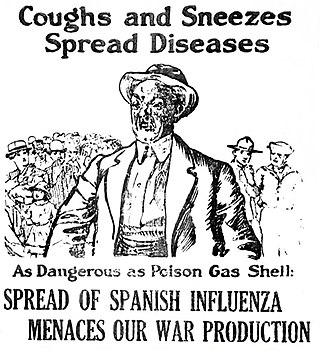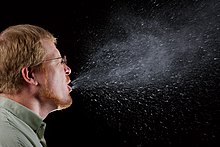
Swine influenza is an infection caused by any of several types of swine influenza viruses. Swine influenza virus (SIV) or swine-origin influenza virus (S-OIV) refers to any strain of the influenza family of viruses that is endemic in pigs. As of 2009, identified SIV strains include influenza C and the subtypes of influenza A known as H1N1, H1N2, H2N1, H3N1, H3N2, and H2N3.

An influenza pandemic is an epidemic of an influenza virus that spreads across a large region and infects a large proportion of the population. There have been six major influenza epidemics in the last 140 years, with the 1918 flu pandemic being the most severe; this is estimated to have been responsible for the deaths of 50–100 million people. The 2009 swine flu pandemic resulted in under 300,000 deaths and is considered relatively mild. These pandemics occur irregularly.

Influenza, commonly known as "the flu" or just "flu", is an infectious disease caused by influenza viruses. Symptoms range from mild to severe and often include fever, runny nose, sore throat, muscle pain, headache, coughing, and fatigue. These symptoms begin one to four days after exposure to the virus and last for about two to eight days. Diarrhea and vomiting can occur, particularly in children. Influenza may progress to pneumonia from the virus or a subsequent bacterial infection. Other complications include acute respiratory distress syndrome, meningitis, encephalitis, and worsening of pre-existing health problems such as asthma and cardiovascular disease.

The elbow bump is an informal greeting where two people touch elbows. Interest in this greeting was renewed during the avian flu scare of 2006, the 2009 swine flu pandemic, the Ebola outbreak of 2014, and the COVID-19 pandemic when health officials supported its use as an alternative to hand-shaking to reduce the spread of germs. During the latter pandemic, authorities advised that even an elbow bump was too risky, and suggested greeting from a distance.

Influenza-like illness (ILI), also known as flu-like syndrome or flu-like symptoms, is a medical diagnosis of possible influenza or other illness causing a set of common symptoms. These include fever, shivering, chills, malaise, dry cough, loss of appetite, body aches, nausea, and sneezing typically in connection with a sudden onset of illness. In most cases, the symptoms are caused by cytokines released by immune system activation, and are thus relatively non-specific.

The 2009 swine flu pandemic, caused by the H1N1/swine flu/influenza virus and declared by the World Health Organization (WHO) from June 2009 to August 2010, was the third recent flu pandemic involving the H1N1 virus. The first identified human case was in La Gloria, Mexico, a rural town in Veracruz. The virus appeared to be a new strain of H1N1 that resulted from a previous triple reassortment of bird, swine, and human flu viruses which further combined with a Eurasian pig flu virus, leading to the term "swine flu".

The 2009 flu pandemic was a global outbreak of a new strain of influenza A virus subtype H1N1, first identified in April 2009, termed Pandemic H1N1/09 virus by the World Health Organization (WHO) and colloquially called swine flu. The outbreak was first observed in Mexico, and quickly spread globally. On 11 June 2009, the WHO declared the outbreak to be a pandemic. The overwhelming majority of patients experienced mild symptoms, but some persons were in higher risk groups, such as those with asthma, diabetes, obesity, heart disease, who were pregnant or had a weakened immune system. In the rare severe cases, around 3–5 days after symptoms manifest, the sufferer's condition declines quickly, often to the point of respiratory failure.

In public health, social distancing, also called physical distancing, is a set of non-pharmaceutical interventions or measures intended to prevent the spread of a contagious disease by maintaining a physical distance between people and reducing the number of times people come into close contact with each other. It usually involves keeping a certain distance from others and avoiding gathering together in large groups.
Influenza prevention involves taking steps that one can use to decrease their chances of contracting flu viruses, such as the Pandemic H1N1/09 virus, responsible for the 2009 flu pandemic.

Public Health England (PHE) was an executive agency of the Department of Health and Social Care in England which began operating on 1 April 2013 to protect and improve health and wellbeing and reduce health inequalities. Its formation came as a result of the reorganisation of the National Health Service (NHS) in England outlined in the Health and Social Care Act 2012. It took on the role of the Health Protection Agency, the National Treatment Agency for Substance Misuse and a number of other health bodies. It was an executive agency of the Department of Health and Social Care, and a distinct delivery organisation with operational autonomy.

Neil Morris Ferguson is a British epidemiologist and professor of mathematical biology, who specialises in the patterns of spread of infectious disease in humans and animals. He is the director of the Jameel Institute, and of the MRC Centre for Global Infectious Disease Analysis, and head of the Department of Infectious Disease Epidemiology in the School of Public Health and Vice-Dean for Academic Development in the Faculty of Medicine, all at Imperial College London.
Sally Bloomfield is a professor at the London School of Hygiene and Tropical Medicine, London, UK. She is an expert on home hygiene research and education and has disputed the notion that we have become “too clean for our own good” and that allergies arise as a result of our “modern obsession with cleanliness”. She has developed strategies for dealing with emerging infectious diseases including SARS and Ebola, and recognizes hygiene as the first step during the early stage before methods such as vaccination become available. During the COVID-19 pandemic, she endorsed the "Catch It, Bin It, Kill It" slogan, reminding people to catch a cough or sneeze in a tissue, bin the tissue immediately and then thoroughly wash hands, to prevent the spread of COVID-19.
"Swine Flu Skank" is a viral UK funky comedy song by British MCs Jstar and Pilot, released during the swine flu pandemic of 2009–2010 and utilising the Department of Health and Social Care's 'catch it, bin it, kill it' campaign slogan, encouraging the public to prevent the flu's spread. It received more than 10,000 views within three hours of its release, and has since accumulated over a million YouTube views.

Hazard controls for COVID-19 in workplaces are the application of occupational safety and health methodologies for hazard controls to the prevention of COVID-19. Vaccination is the most effective way to protect against severe illness or death from COVID-19. Multiple layers of controls are recommended, including measures such as remote work and flextime, increased ventilation, personal protective equipment (PPE) and face coverings, social distancing, and enhanced cleaning programs.

"Coughs and sneezes spread diseases" was a slogan first used in the United States during the 1918–20 influenza pandemic – later used in the Second World War by Ministries of Health in Commonwealth countries – to encourage good public hygiene to halt the spread of the common cold, influenza and other respiratory illnesses.
Exercise Cygnus was a three-day simulation exercise carried out by the UK Government in October 2016 to estimate the impact of a hypothetical H2N2 influenza pandemic on the United Kingdom. It aimed to identify strengths and weaknesses within the United Kingdom health system and emergency response chain by putting it under significant strain, providing insight on the country's resilience and any future ameliorations required. It was conducted by Public Health England representing the Department of Health and Social Care, as part of a project led by the "Emergency Preparedness, Resilience and Response Partnership Group". Twelve government departments across Scotland, Wales and Northern Ireland, as well as local resilience forums (LRFs) participated. More than 950 workers from those organisations, prisons and local or central government were involved during the three-day simulation, and their ability to cope under situations of high medical stress was tested.
Planning and preparing for pandemics has happened in countries and international organizations. The World Health Organization writes recommendations and guidelines, though there is no sustained mechanism to review countries' preparedness for epidemics and their rapid response abilities. National action depends on national governments. In 2005–2006, before the 2009 swine flu pandemic and during the decade following it, the governments in the United States, France, UK, and others managed strategic health equipment stocks, but they often reduced stocks after the 2009 pandemic in order to reduce costs.
In epidemiology, a non-pharmaceutical intervention (NPI) is any method used to reduce the spread of an epidemic disease without requiring pharmaceutical drug treatments. Examples of non-pharmaceutical interventions that reduce the spread of infectious diseases include wearing a face mask and staying away from sick people.

Source control is a strategy for reducing disease transmission by blocking respiratory secretions produced through speaking, coughing, sneezing or singing. Surgical masks are commonly used for this purpose, with cloth face masks recommended for use by the public only in epidemic situations when there are shortages of surgical masks. In addition, respiratory etiquette such as covering the mouth and nose with a tissue when coughing can be considered source control. In diseases transmitted by droplets or aerosols, understanding air flow, particle and aerosol transport may lead to rational infrastructural source control measures that minimize exposure of susceptible persons.

The United Kingdom's response to the COVID-19 pandemic consists of various measures by the healthcare community, the British and devolved governments, the military and the research sector.

















